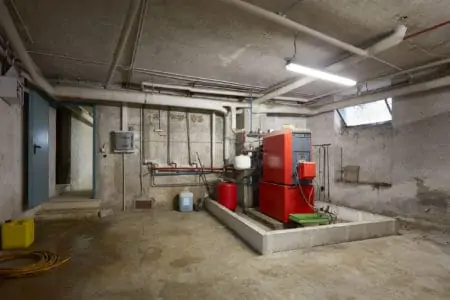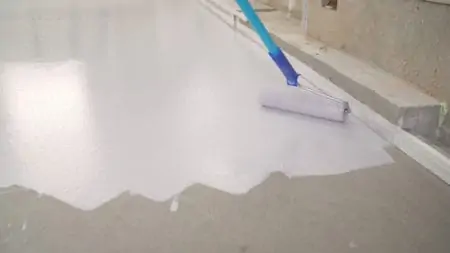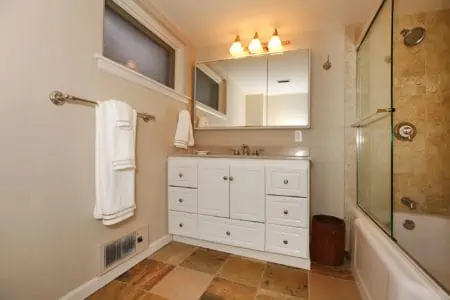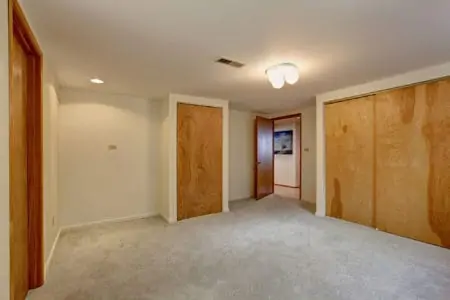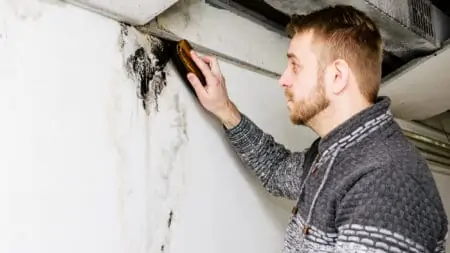If you are resigned to the fact that your basement smells like a laundry basket full of dirty socks, think again. Knowing how to get rid of that musty smell in the basement could transform an unloved room into a usable space.
This article explains how to get rid of that musty smell in your basement and helps you identify the likely culprits.
Key Takeaways
- Locate the source of the musty smell, which is likely caused by mold and mildew growth in your basement.
- Use a dehumidifier to remove moisture from the air and control humidity levels to prevent mold growth.
- Regularly inspect and repair any leaks, cracks, or issues that may cause water to enter the basement.
- Keep the basement well-ventilated and clean to minimize the chances of mold growth and musty smells.
Is It Normal for Basements to Smell Musty?
Your basement sits below ground, making it the perfect location for mold, dampness, and mildew. The soil pressing against your basement walls transfers cold through the brickwork, making your sub-floor space chillier than the rest of your house.
So, it is normal to have a slightly smelly basement (akin to wet dogs). But, knowing what a typical basement odor is and when to be concerned is crucial.
If you notice black mold growing, you will need to deal with the problem ASAP or risk it spreading. Mold spores are bad news for your basement because they cause massive amounts of damage and can be tricky to eliminate.
And then there are the health implications. Mold spores irritate your lungs, causing a problem for people who have asthma and other breathing conditions.
Causes of a Musty Basement Smell
Basements are typically the laundry room in the house, which means your washing machine could be leaking water. Also, stale or standing water in pipes could emit that musty smell.
If you can smell something earthy but can’t see any mold spores, you may need to investigate further. Another cause could be water seeping through the walls. Look for places where pipes and drains enter or leave the property.
Heat and cold causes condensation, which makes the walls wet (another perfect breeding ground for mold spores). Another cause could be a lack of ventilation. Basements lack good airflow due to a lack of ventilation.
Moisture never dries out if the air can’t flow, and mold moves in. The other culprit could be the season. Dry soil keeps moisture to a minimum in the summer months, whereas the ground gets saturated in the winter.
My Basement Is Dry But Still Smells Musty
You may still have enough mold or mildew spores to make your basement smell musty even when it is dry. Your basement dries out in the warmer months, but it is still possible that mold and mildew exist in hidden corners.
It could also be the residue of a mold infestation, and the basement needs airing to get rid of that earthy smell. Another culprit could be the concrete floor. Concrete absorbs moisture from the soil below.
The concrete slab floor could be a haven for mold and mildew growth even when the walls and ceiling may be dry. It causes the foundations to become saturated. Also, while the basement may be dry, it is a dark and cold room when it is closed up.
These are perfect conditions for fungal growth.
How to Get Rid of a Musty Smell in Your Basement
So, your basement smells worse than a pro-football team’s locker room after a big game. But what can you do to remove the stink? Don’t panic! We have 10 odor-eliminating solutions to put a smile back on your face.
1. Identify the Source
Your nose is the best tool to identify the odors in your basement. You can’t remove the smell if you don’t know where or what it is. Remove appliances, check near water sources like sinks and drains, and feel behind cabinets and furniture.
If your finished basement has a floor drain or trapped water in a P-trap, that could be another reason why you smell that musty odor. Alternatively, a P-trap with no water could also be an issue as odors seep back into the basement.
The smell is a symptom of the cause, so locating the source means you can tackle it right away. Other areas to keep in mind include:
- Basement windows could be leaky or encourage condensation.
- Exterior entrances can also be a common cause of water ingress.
- Doors from the floor above.
- Bathroom plumbing from the floor above.
The culprit could also be groundwater. If the land around your basement slopes the wrong way, it could channel water towards your home rather than away. Eventually, the water finds a way in (it always does).
Another cause could be the type of soil your house is built on. A high clay content retains moisture in the wetter months, trapping it against your basement walls. Soil with many stones and larger fragments dries out faster because the water drains away naturally.
Remember
Fabric furniture, carpets, and curtains are breeding grounds for mold and mildew. Your basement may be dry after a flood, but the fabric continues to harbor fungal spores.
2. Keep On Top of Repairs
You may think the musty odor has gone, but unless you make the necessary repairs, it will come back to haunt you. Those leaky windows won’t fix themselves, and that door will still let in water.
That cracked pipe will still pour water into your basement every time you run the washing machine. Sometimes, it can be easy to shut the basement door and put those issues to the back of your mind. However, out of sight does not mean out of trouble.
Ignoring the issue will just make things worse and give you a bigger headache further down the line.
Some solutions are easy, and others are more complex and expensive. Simply insulating your pipes is a quick and easy fix, but exterior ground excavation is costly and complicated. That said, who said owning a home was cheap.
They are called money pits for a reason!
3. Deal With the Smell
Where there is an odor, there’s a problem, so once you’ve made the necessary repairs, fix the stink. The good news is the solution is straightforward. Placing bowls of baking soda around the basement floor to absorb the moisture should work.
You will notice the odor diminishing after a couple of days. An alternative is to use cat litter because it soaks up a lot of moisture. You can buy moisture traps, like this DampRid, designed to tackle foul smells.
You can’t beat a good spring clean of your basement. Once you’ve banished the odors with the deodorizer, get out your mop and bucket and scrub like hell.
You don’t need expensive chemicals to tackle the job; white vinegar and a water mix could be the answer. Spray it liberally around the spots that attract mold and mildew, and then scrub with a brush or cloth.
Again, pay particular attention to fabrics, furniture, and carpets. Moisture-absorbing materials harbor fungal spores and aid their growth. You could always buy a steam cleaner, like this Bissell ProHeat Revolution, to make light work of carpets and soft furnishings.
4. Regulate Humidity
Mold and mildew form because of damp, dark, and wet conditions. Regulating the airflow, heat, and moisture content controls the spread of fungal growth and keeps odors at bay.
Dehumidifiers, like this hOmelabs 3,000 Sq. Ft. Energy Star Moisture Extractor, are ideal for removing humidity from large basements and crawl spaces. You should be able to attach a drain hose and run it outside if your basement is exceptionally wet.
If your basement has heating, turn it up and warm the room to remove the moisture. Or increase the airflow by opening windows and external doors.
You should aim to keep your humidity levels at around 40 to 60 percent. Above 60 percent encourages mold to grow. Another way to control moisture is to install a window fan if your window doesn’t open.
It draws out the moist air and replaces it with drier and fresher air.
5. Insulate Exposed Pipes
Exposed pipework attracts moisture by creating condensation. If you spot your pipes sweating and water dripping, buy some insulation foam and cover the pipes.
You can pick up foam covers, like this M-D Building Products Pipe Insulation, for between $10 and $20.
6. Unblock Window Wells
If you see water pooling at the bottom of your basement window and failing to drain away, you will need to unblock the wells. Window wells are small channels that allow water to run away from the frame.
The issue is quickly resolved by sweeping away leaves and debris from the outside of the window. Occasionally, the well itself becomes clogged. Remove the rubber seal around the window and poke a knife blade into the well to free the blockage.
7. Remove Upholstered Furniture
Soft furnishings, cushions, and other fabrics encourage mold growth in damp environments. Sometimes, you can tackle the problem by using a steam cleaner. However, removing the contaminated item might be the best option if the fungal growth is substantial.
You could also try vacuuming the furniture first and then rubbing it down with a solution of equal parts rubbing alcohol and water. If it’s a sunny day, drag it outside to air dry.
8. Remove Mold and Mildew
There are several ways to remove mold and mildew from your basement walls, floors, and ceilings. Homemade solutions are the best methods. Here are a few worth mentioning:
- Equal parts water and white vinegar in a spray bottle.
- Vinegar, baking soda, and water in a spray bottle.
- Bicarbonate of soda, mixed into a paste and smeared onto the mold.
- Neat white vinegar (if you can stand the smell).
You can also use bleach to tackle fungal growth. You can buy it in powder form, like this Comet Cleaner with Bleach Powder or liquid form. Powdered bleach might be better because it mixes into a thick paste to coat the mildew and kill it.
You could also use Borax Powder, a multipurpose cleaner that works well on mold spores, to kill the fungus. Simply mix a cup of borax into a gallon of hot water, and soak a clean rag. Dab the rag on the affected spot to kill the growth.
It is particularly effective on heavily soiled areas, where the odor has turned sour, like gone-off milk. When the spores have disappeared, rinse the area with clean water and dry with a cloth.
Another method is to sand the mold away and then use a vacuum cleaner to suck up the contaminated dust. Then spray the treated area with white vinegar and water to sanitize, and dry with a cloth.
9. Activated Charcoal and Coffee Grounds
If you can’t afford a dehumidifier, another great remedy is to place bowls of activated carbon in the corners of the room. Concentrate on areas where moisture attack is most likely to happen. Think sinks, drains, washing machines, and pipework.
Coffee grounds absorb moisture and deodorize at the same time. Plus, your basement will smell divine.
10. Check Exterior Water Flow
The soil piled against your basement walls should slope away from your home. It allows the water to run off naturally, removing the moisture from the basement. Sometimes, debris and mud build-up next to your basement and block the water flow.
Sweep away any accumulated leaves, remove soil that blocks the water flow, and ensure that the water does not pool around windows and doors.
Soil can become waterlogged, which seeps into the walls of your basement. Establishing a natural soak-away removes the issue. It involves digging trenches around your basement walls and filling them with small rocks and pebbles.
The rainwater soaks away faster, removing instances of pooling against your basement walls.
Preventing Musty Smells
Prevention is always better than the cure, so keeping musty smells from forming in the first place is the ideal scenario.
We’ve already mentioned that the best way to control odors is to regulate the humidity in the basement. Here are some more exclusive ways to achieve this:
Salt
Bowls of salt placed around the basement absorb moisture. You can use table salt or dishwasher salt. Concentrate on areas where water and mold are likely to grow.
Sawdust
Sprinkling sawdust on affected areas is an excellent way to soak up moisture and prevent odors.
Remove Paper and Cardboard
Paper and cardboard are excellent breeders of mold and mildew. The discarded paper penetrates the damp concrete floor and draws the water from the ground. Cardboard does the same, so ensuring you remove it helps control odors.
Install a Box Fan
Box fans, like this Hurricane 20-inch Classic Fan, help to move air around the basement and ensure that the walls do not become damp. You can install a fan in a basement window to extract the moist air or simply place two of these fans on the floor.
FAQs
Get Rid of Odors
Your basement doesn’t have to smell musty. By taking a few simple steps, you can banish odors and remove the risk of mold and mildew. Basements are wet and cold environments, attracting fungal growth, but you can banish mold by regulating the humidity.
Turn your basement into a much-loved space and create that extra room you always wanted.
